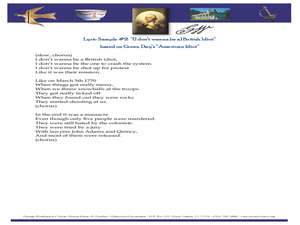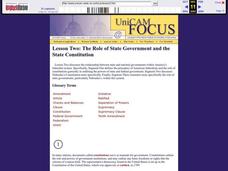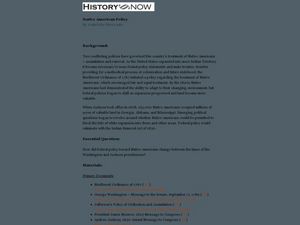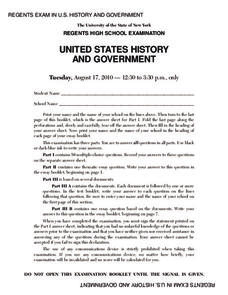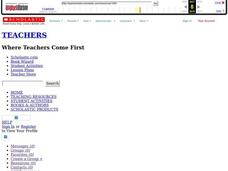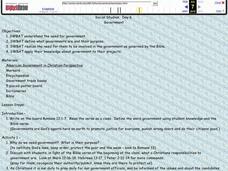Curated OER
Native American History
Students examine how Chief Joseph attempted to challenge stereotypes about Native Americans. In this Native American history instructional activity, students read "An Indian's Views of Indian Affairs," and then paraphrase the selection....
K12 Reader
Three Levels of Government
Help your learners work their way through a reading assignment for informational text. Using context clues, they answer five comprehension question based on a short passage about the three levels of government: local government, state...
North Carolina Consortium for Middle East Studies
Missing Pieces of the Puzzle: African Americans in Revolutionary Times
What's missing from most studies of the American Revolutionary War is information about the role African Americans played in the conflict. To correct this oversight, middle schoolers research groups like the Black Loyalists and ...
Curated OER
Democracy and Representative Government
Students complete a worksheet about the government and identify the characteristics of different governments. In this government lesson plan, students define representative democracy and complete a worksheet.
Curated OER
American Colonists Protest Song
Middle schoolers explore the role of protest songs. In this early American history instructional activity, students research the acts passed by the British that angered colonists. Middle schoolers then listen to protest songs from...
Curated OER
The Role of State Government and the State Constitution
Students investigate the relationship between state and national governments. They define the principles of American federalism how the constitution outlines the powers of state and federal government. Lesson focuses on Nebraska...
Curated OER
Understanding American Values
Scholars read books and discuss emotions that lead up to the American Revolution. They also discuss vocabulary and use reference materials to research the Internet for causes and sentiment that led to the American Revolution.
K20 LEARN
Allotment in Indian Territory: Land Openings in Indian Territory
To understand how the allotment policy embedded in the Dawes Act, passed by the U.S. government in 1887, affected the tribal sovereignty of Native Americans, young historians examine various maps and documents and Supreme Court...
Center for History Education
Speaking Freely In the Soviet Union's Autocratic Government
Speak your mind! The lesson explores the difference in free speech between the United States and the Soviet Union. Academics review the constitutions of both governments, political cartoons, and case studies to understand how freedom of...
Curated OER
George Washington Crossing the Delaware: A Study of Setting and Character
Learners examine "Washington Crossing the Delaware." In this American Revolution lesson, students analyze the painting, research its background, and then perform skits based on their findings.
New York State Education Department
US History and Government Examination: June 2017
Ready for a test that uses primary sources as a tool to assess comprehension? Learners answer multiple choice, essay, and short answer questions to demonstrate their understanding of American history.
Curated OER
Native American Policy
Students examine federal policies regarding Native Americans. In this Native American assimilation and removal policies lesson, students conduct research to compare the changes in federal policy regarding Native Americans between the...
PBS
Pearl Harbor and the Internment of Japanese Americans during World War II
Balancing national security and civil liberties can be tricky. To appreciate the tension between these two concepts, class members investigate the Japanese attack on the U.S. Naval Base at Pearl Harbor and President Franklin D....
New York State Education Department
US History and Government Examination: August 2010
Geography has played a complex role in America history. The Atlantic Ocean has served as a buffer to protect the United States from European Wars, but its proximity to Cuba, however, left it vulnerable to nuclear war during the Cuban...
Curated OER
The Home Front: Convincing Americans to Help America Prepare
Sixth graders examine the actions of the U.S. Government after the attack on Pearl Harbor. In this preparation for war lesson, 6th graders analyze WWII posters and view a clip on the American Home Front. Students discuss and list the...
Curated OER
The Beginnings of Constitutional Government
Students examine excerpts of Thomas Paine's Common Sense. In this early American history lesson, students read Paine's pamphlet and analyze the information according the rubric provided.
Curated OER
Governance- Grade 9
Ninth graders participate in talking circles about how their classroom will function. In this self-governance lesson, 9th graders participate in talking circle activities to create rules that will govern their class. Students compare...
Curated OER
A Salute to American Symbols
Students research American symbols. In this American History lesson, students listen to the story The Wall and discuss the Vietnam Veterans Memorial. They also listen to One Nation and research an American Symbol to create a...
Curated OER
What is Brazil's Government Like?
Students compare and contrast the American system of government with that of Brazil. They research how the Brazilian govenment functions.
Stanford University
Ansel Adams at Manzanar
Analyzing photos from Ansel Adams of Manzanar—a camp where the American government imprisoned thousands of Japanese-Americans during World War II—individuals consider what images have to say about this period in American history....
Curated OER
Government
Perfect for a Christian or private school setting, this lesson has learners use their Bible to help them identify the purpose of the government. They examine specific Bible verses then use them to define the government and the...
National Endowment for the Humanities
The Preamble to the Constitution: A Close Reading Lesson
"We the people of the United States, in order to form a more perfect union..." These familiar lines begin the Preamble to the Constitution, but do learners know what they mean? A close reading exercise takes a look at the language of the...
iCivics
Why Government?
Why do people create governments? Where did we get our ideas about government? This is a fantastic introductory lesson for your American government class that begins by reviewing the philosophies of Thomas Hobbes and John Locke in...
Curated OER
Lesson: Allison Smith: What Are You Fighting For?
Trench art is a nontraditional art form created by soldiers in trenches during wartime. Artist Allison Smith connects her art to the American Revolution and the question: "What are you fighting for?" Kids examine her art, how it connects...






